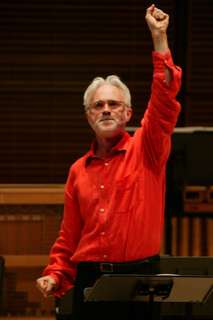|
Back
The Glory of the Lord New York
Stern Auditorium, Carnegie Hall
12/14/2009 -
John Adams: El Niño
Dawn Upshaw (Soprano), Michelle DeYoung (Mezzo-Soprano), Eric Owens (Bass-Baritone), Daniel Bubeck, Brian Cummings, Steven Rickards (Countertenors)
Westminster Symphonic Choir, Joe Miller (Conductor), The Brooklyn Youth Chorus, Dianne Berkun (Director), Mark Grey (Sound Design), Orchestra of St. Luke’s, John Adams (Conductor)

J. Adams (© Chris Lee)
The two central figures in this most ravishing oratorio are Mary, the eternal vision of all women; and Herod, the totemic figure for those who are responsible for mass slaughters.
Within the context of El Niño, Mary is the child-bearing woman, the confused virgin mother of El Niño, the baby. But the inner beauty of this 16-year-old girl comes from giving birth to all the children of our world. Herod, omitted from Handel’s Messiah, here not only slaughters the Innocents, but in the remarkable centerpiece of the opera, the longest aria/chorus, the eternal Herod slaughtered the Aztecs in 1521, slaughtered Mexican students in 1968, and presumably was behind the slaughter of Jews, Gypsies and homosexuals in Nazi Germany, Palestinians in Gaza, Cambodians in Kampuchea etc etc.
And alas, etc ad infinitum.
As in all his choral pieces, John Adams gives meanings far greater than the historical or musical backgrounds. Historically, El Niño is based on the birth of Jesus, the coming of the Magi, the slaughter of the Innocents and the flight into Egypt. Yet the libretto is filled with mystical mythical passages from the Apocrypha, Medieval poetry and Mystery Plays, and Spanish poems over five centuries. Musically, John Adams retains his characteristics chugging, four-square, diatonic “old-fashioned” harmony and meters. But this music was so strong and powerful Sunday evening that it becomes a work of major importance.
Originally written for the Millennium, Messrs Adams and Sellars composed El Nino both for theatre (with dancers and a silent movie) and pure oratorio performed in Carnegie Hall last night. The mighty voices of the Westminster Symphonic Choir, the spot-on precision of St. Luke’s Orchestra conducted by the composer, seven soloists, including three countertenors, and finally, the Brooklyn Youth Chorus, which sung a finale which was so hypnotic, solemn and so in tune with the final Spanish word–”Poesia”, Poem–that one could cry.
From the beginning, with typical Adams rumbling orchestra and a 13th Century poem, “I sing of a maiden”, one feels that Mr. Adams has taken an ancient story, and in some ways blended both archaic and modern music to deal with it. In “The Christmas Star”, we go back to the 14th Century, with the choir singing a poem by Hildegard von Bingen with cantus firmus (an underlying chant) underneath the soloists. For the Magnificat, set by so many composers, Mr. Adams has music which echoes that of his Nixon in China, yet sung with another passion by Dawn Upshaw. A Spanish poem meaning “Because my Lord was born to suffer” the entire choir sings, but the alto voices in orchestra and chorus almost resonate like the women’s choir of Bach’s Magnificat.
While the work is in two sections, the energy and the tales form a single unit. But this Nativity is different from all others, since the stories come from so many sources. Like tales from the late Levi-Strauss, we have legends that leap from the Amazon forests, or tales of Jesus calming dragons, and, most beautiful of all, Jesus transforming a palm tree into water for his Holy Parents, Mr. Adams’ orchestral water flowing as smoothly as the words of the chorus and soloists.
It’s almost instinctive to mention Dawn Upshaw before anyone else. As in everything she does, she lives her part, partly speaking, partly singing. El Niño was composed especially for her, and those wonderful leaps of octaves (I almost wrote “leaps of faith”) were for the strength as well as the drama. The great Michelle DeYoung was equally forceful in her music, but Eric Owens–whether as the angry Joseph, the evil Herod or the omnipoetnet God–was towering. He also sung the only aria in Handel’s Messiah, asking why the heavens and earth shake. Both orchestra and Mr. Owens were emotional enough to make Carnegie Hall almost topple like the walls of Jericho.
The three countertenors were, yes, the Magi, but also were three Gabriels, and played other parts in beautiful harmony. Best, seeing Mr. Adams conduct here is a sight in itself, for he is clear, forceful and as passionate as the music he created.
But why only one performance this year? Dozens of Messiahs this month belie the Biblical promise of a single Redeemer. Methinks it’s time for us to gear ourselves for the usual Nutcracker, a Messiah or two, and–for children and adults, for atheists and believers, and for all who feel the spirit of every day of the year–Mr. Adams’ El Niño should be a religious obligation.
Harry Rolnick
|